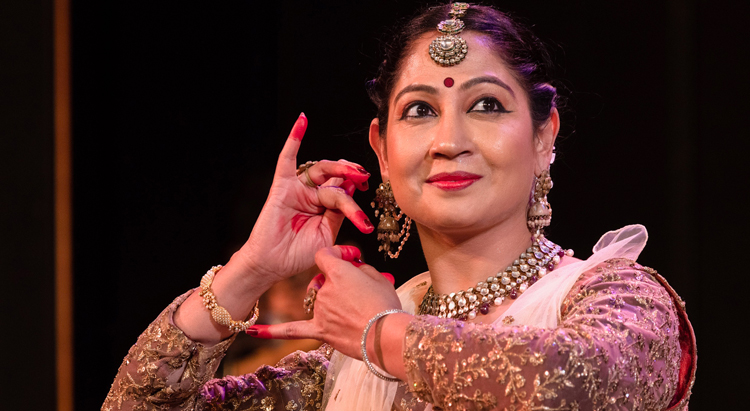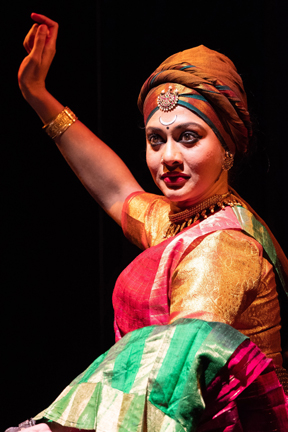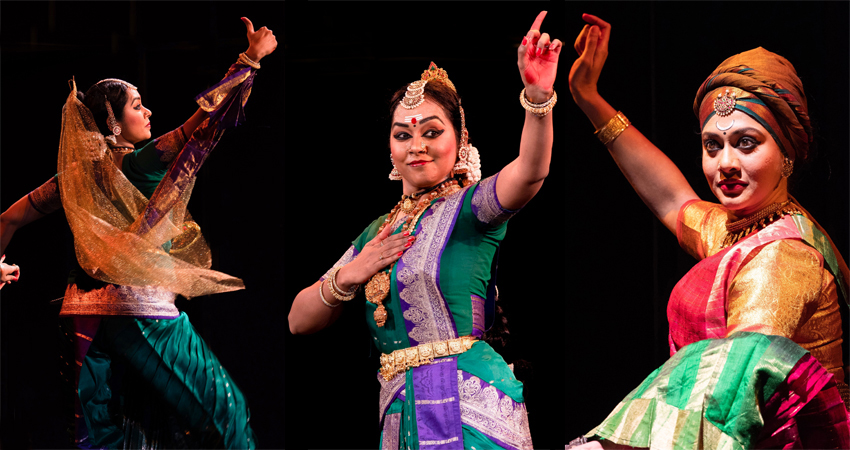Art uplifts us and enriches our lives. Over the course of the last year, our hearts were crushed when the entire industry was brought to its knees by the pandemic. Today, normalcy is still a far cry but the classical dance field began making alternate mediums the new normal. The second half of 2020 brought a new tide as organisers started setting up digital platforms that honoured artistes for their effort and time. Towards the end of the year, rasikas began noticing the quality art being offered right to their homes and willingly bought tickets to view shows. 2021 started with a bang as connoisseurs welcomed ‘Evam’, a festival thoughtfully curated by Keerthana Ravi, a Bharathanatyam dancer, and her Rasabodhi team. For five years Evam was only available to Mumbaikars and every edition left the spectators wanting more. This year’s move to the digital medium was in tune with the times and also a deserved one that showcased quality art to a larger, global audience.

Usha R K is India’s leading arts impresario with decades of unmatched service to the arts in her court and is currently heading JNCC at Moscow. Having worked with the biggest names of film, music and dance, she had the experience to propel herself amidst the greatest living legends of our country. Yet, Usha R K did the unprecedented. She began conceptualising brilliant themes and placed them in the hands of our country’s young and promising talent. Over the past decade and a half, we have watched hit after hit, adorning some of the biggest stages and sought-after platforms of our country: all with the banner ‘a Usha RK event’. One of her recent productions, Veerbala- portraiture of 3 brave women, once again brought to the fore three young and brilliant dancers. Through the erasure of geographical borders, Moscow, Mumbai, Bangalore and Delhi united to create a visual masterpiece.
Poorna Acharya began her depiction of Rani Lakshmibai of Jhansi in Kathak. At once, the clarity of video, the dramatic effect of light and smoke caught one’s eye. Poorna showcased the character of Lakshmibai clearly as a courageous and strong woman who was also extremely compassionate. Her portrayal of vatsalya was simple yet endearing. Her veeram was subdued yet commanding. Prolonged vatsalya sections enhanced the depiction of the dilemma faced by the queen, which led her to carry her child on her back while fighting her enemies: imagery vividly stuck in our minds. To show fighting scenes and warrior moves through the vocabulary of Kathak can be quite challenging but intelligent choreography by Gurus Murali Mohan Kalvakalva and Nandini Mehta and elements of Kalaripayattu weaved a beautiful pattern of movement apt for the production.

Poorna was in her element throughout the presentation and gave audiences some aha moments during close-ups. Grand costumery, dramatic lighting by Sri Nagraj, interspersing of lyrics with Kathak bhols and music composition by Praveen D Rao uplifted the presentation and gave viewers wonderful memories to carry.

Shivaranjani Harish essayed the character of Kittoor Rani Chennamma with the aplomb and finesse of a seasoned performer. Her presentation began with an element of suspense as she presented a nrittagucha with her back to the camera. This brought to a viewer’s mind the ritual of ‘paatra parichaya’ adapted in the Yakshgana art form of Karnataka, where a new character is introduced to the audience slowly from behind a screen held by two people. The way Shivaranjini adapted this into the solo Bharathanatyam format was clever and interesting.
Chennamma’s arrival was ‘announced’ in the historic fashion, followed by a segment that traced her life story. Guru Kiran Subramanyam’s inimitable composing style was evident in the Trikala jathi which portrayed Chennamma’s lessons in warfare as a child, right up to her marrying King Mallasarja. Shivaranjani’s subtle yet powerful abhinaya was a treat during the close-up shots. Her deep sorrow on the loss of her husband and son was engulfed in an unshed teardrop which could only be seen by us because of this visual medium. A stand out feature was the use of vachika abhinaya, not akin to Bharathanatyam, through the famous dialogue, “Kappa beke, kappa?” as she challenged the Britishers’ move to annexe and collect tax. Shivaranjani’s presentation too drew inspiration from Kalaripayattu for the fight sequences, which were brought to life more so with brilliant musical support by Ramya Janakiraman (nattuvangam), D.S. Srivatsa (vocal), Lingaraju (mridangam) and Mahesh Swamy (flute). Shivaranjani ended with a poignant message to the women of today, conveying that while we may all face challenges and go through several emotions, it is important to fight for a greater cause.

Rani Rudrama Devi’s inspiring tale was brought to life by refined dancer Dakshina Vaidhyanathan Baghel. History, depending on where you read it, states the Rudrama Devi died twice, 6 years apart! Keeping this in mind, Dakshina created a connection in the timelines with the guesswork of what could have happened. Her presentation began with excerpts from Perini Natyam that the queen used to boost her army’s morale in the form of exercises. The very fact that a form of dance was taught to soldiers during that time speaks highly of the people under the Kakatiya rule. After almost being killed by her own dynasty’s subordinate King the first time, Rudrama Devi gathers all the resolve she has to train her grandson in order to rule over the land. Her determination to see the Kakatiya flag fly high was made evident by Dakshina, who led us through an emotional, patriotic and heart-wrenching journey filled with ups and downs, through her focused and powerful abhinaya. She brought to us the queen’s valour, grandmotherly compassion and dedication to social developments like rainwater harvesting and building hospitals with great ease. But what ultimately stood out for prowess was that the climax fight and victory that ensued was only shown in Rudrama Devi’s reaction and emotions by Dakshina.
No adjective can sufficiently describe the effect of the music score set by Dr. S Vaudevan. Sudha Raghuraman’s deep hold on delivery of Dandibotla Vaikuntha Narayana Murthy’s lyrics, modulation of intonation in words and perfection of the tune is a dream for every dancer. Equally supportive nattuvangam by Himanshu Srivastava, mridangam by Sumod Sreedharan and flute by G.Raghuraman left every viewer haunted by ‘Jayamu’ as they carried the story of Rudrama Devi- the Rani who died twice.
[adrotate group=”9″]
All three queens faced similar challenges and their stories carry repetitive events like being subject to the Doctrine of Lapse on not having an heir. And they were all stories that the Indian audiences were familiar with. What could have been a monotonous 90 minutes surprised the viewers with distinctive content in each portrayal. Usha R K’s Veerbala brought us a fresh approach to their stories, with new lyrics, from-scratch compositions and vivid costumery which highlighted the exclusive choreographies. It was a fine lesson in converting the mundane into something extraordinary.
Evam was indeed off to a brilliant start with Day 1. Stay tuned for reports on the remaining productions featured in the festival.
About Contributor- Shilpa Nanjappa is a Bharatanatyam soloist and a disciple of Guru Padmini Ramachandran.










